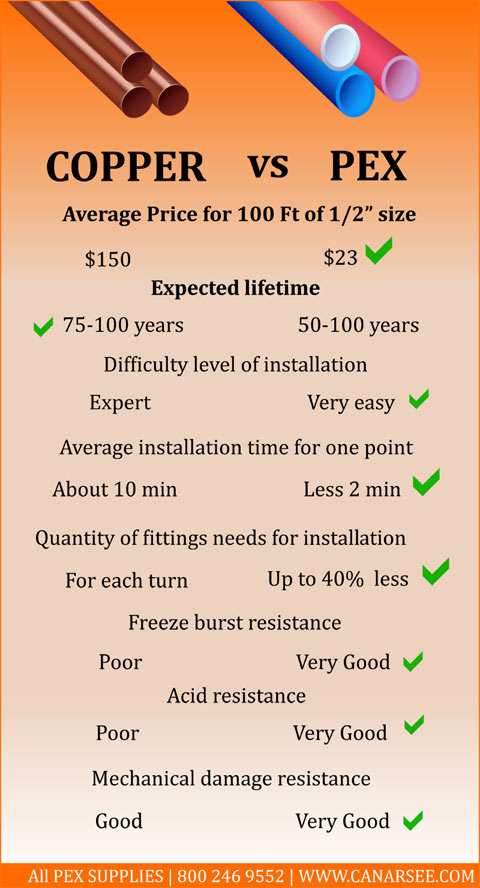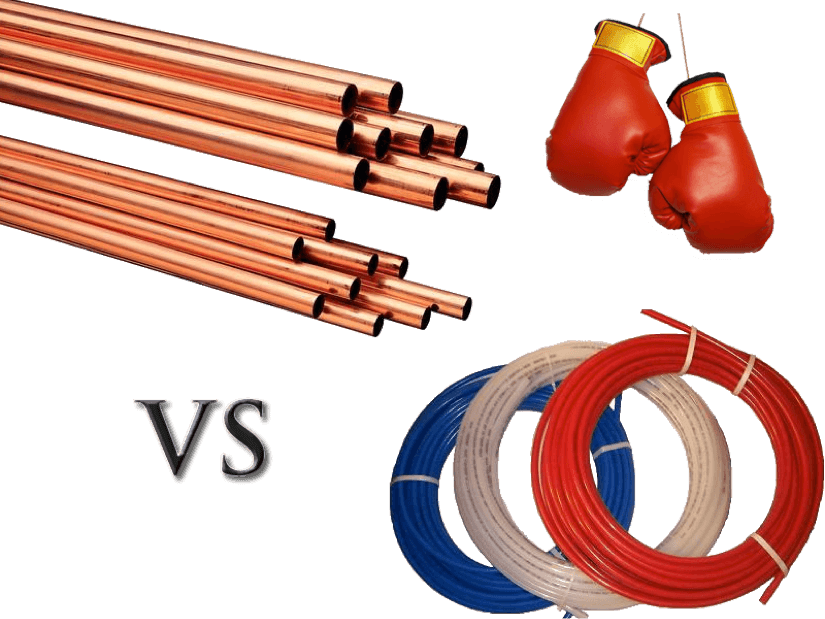In this article, you’ll gain a comprehensive understanding of the key differences between PEX and copper pipes. Whether you’re a homeowner looking to undertake a plumbing project or simply curious about the materials used for water distribution, we’ll explore the advantages, drawbacks, and overall performance of PEX and copper pipes. By the end of this article, you’ll be equipped with the knowledge to make an informed decision for your plumbing needs. Let’s begin our journey into the world of PEX vs. Copper pipes!

1. What are PEX and Copper Pipes?
PEX and copper pipes are both types of plumbing pipes commonly used in residential and commercial buildings. Each material has its own unique characteristics and advantages, which make them suitable for different applications.
1.1 Definition of PEX Pipes
PEX, or cross-linked polyethylene, pipes are made of a flexible plastic material that is designed for the transportation of water. PEX pipes are typically color-coded for easy identification and come in various sizes to accommodate different plumbing needs.
1.2 Definition of Copper Pipes
Copper pipes, on the other hand, are made of copper metal and have been used in plumbing systems for centuries. Copper pipes are known for their durability and excellent heat conductivity, making them a popular choice for both residential and commercial applications.
2. Advantages of PEX Pipes
PEX pipes offer several advantages that make them a preferred choice for many plumbers and homeowners.
2.1 Flexibility and Ease of Installation
One of the biggest advantages of PEX pipes is their flexibility, which allows for easy installation even in tight spaces or around obstacles. PEX pipes can be bent without the need for additional fittings, reducing the chances of leaks and providing a more efficient plumbing system.
2.2 Resistance to Corrosion
PEX pipes are highly resistant to corrosion, unlike copper pipes that may deteriorate over time due to exposure to certain water conditions. This resistance to corrosion ensures that PEX pipes can withstand the test of time, resulting in a longer lifespan for the plumbing system.
2.3 Resistance to Freeze Damage
Another benefit of PEX pipes is their ability to withstand freezing temperatures without bursting. Unlike copper pipes, which can crack or burst when exposed to extreme cold, PEX pipes have a certain degree of flexibility that allows them to expand and contract without causing any damage.
2.4 Cost-effective
PEX pipes are generally more cost-effective than copper pipes, especially when considering the materials and labor involved in installation. PEX pipes are less expensive to purchase and require fewer fittings and connections, resulting in reduced installation costs overall.

3. Disadvantages of PEX Pipes
While PEX pipes have numerous advantages, there are also a few disadvantages that should be taken into consideration.
3.1 Limited Compatibility with Hot Water
One drawback of PEX pipes is their limited compatibility with hot water. PEX pipes may become damaged or weakened when exposed to high temperatures, which could potentially lead to leaks or bursts. Therefore, it is essential to consider the intended use of the plumbing system before choosing PEX pipes.
3.2 Potential for Leaching Chemicals
Some studies have shown that PEX pipes may have the potential to leach certain chemicals, such as volatile organic compounds (VOCs), into the water supply. While the levels of these chemicals are generally deemed safe, individuals with specific health concerns may prefer alternative pipe materials.
3.3 Vulnerability to UV Rays
PEX pipes are susceptible to damage from prolonged exposure to ultraviolet (UV) rays. If installed outdoors, PEX pipes should be properly shielded or protected to prevent degradation caused by the sun’s UV rays. This vulnerability to UV rays limits the applications of PEX pipes in certain outdoor plumbing scenarios.
3.4 Shorter Lifespan Compared to Copper
While PEX pipes are durable, they generally have a shorter expected lifespan compared to copper pipes. Copper pipes have been known to last for decades, whereas the lifespan of PEX pipes may vary depending on factors such as water quality and installation conditions.
4. Advantages of Copper Pipes
Copper pipes have several advantages that have made them a staple in plumbing systems for many years.
4.1 Durability and Longevity
One of the key advantages of copper pipes is their durability and longevity. Copper is a highly durable material that can resist corrosion, withstand high water pressure, and endure extreme temperature variations. With proper installation and maintenance, copper pipes can last for several decades.
4.2 Excellent Heat Conductivity
Copper pipes excel in terms of heat conductivity, making them ideal for applications that involve hot water or heating systems. Copper pipes can effectively transfer heat from the water source to the desired location, ensuring a reliable and efficient distribution of hot water throughout the plumbing system.
4.3 Proven Track Record
Copper pipes have been used in plumbing systems for centuries and have a proven track record of reliability. Many plumbing professionals prefer copper pipes for their excellent performance and long history of successful usage. The familiarity and trust in copper pipes contribute to their continued popularity.
4.4 Recyclable and Environmentally Friendly
Copper is a recyclable material, and copper pipes can be recycled once they reach the end of their lifespan. This recyclability makes copper pipes an environmentally friendly choice for plumbing systems, as it reduces waste and the need for new raw materials.

5. Disadvantages of Copper Pipes
While copper pipes have many advantages, there are also a few disadvantages to consider.
5.1 Prone to Corrosion
Although copper is generally resistant to corrosion, certain water conditions can cause the copper pipes to corrode over time. Factors such as high mineral content, aggressive water pH levels, or exposure to certain chemicals can contribute to corrosion in copper pipes. Regular maintenance and monitoring of water quality are necessary to mitigate this risk.
5.2 Difficult and Time-consuming Installation
Compared to PEX pipes, the installation of copper pipes can be more challenging and time-consuming. Copper pipes require skilled professionals to solder and join the fittings securely, which adds to the overall installation time and cost. The complexity of installation may also limit DIY enthusiasts from using copper pipes.
5.3 Higher Cost
Copper pipes tend to be more expensive than PEX pipes, both in terms of material costs and installation expenses. The higher cost of copper pipes can be attributed to the premium quality and durability of the material, as well as the labor-intensive nature of the installation process.
5.4 Potential Health Concerns
There have been some concerns regarding the potential health risks associated with copper pipes. While copper is considered safe for most applications, it can interact with certain water conditions and contribute to the presence of copper in drinking water. Although copper toxicity is rare, individuals with copper sensitivities may prefer alternative plumbing materials.
6. Applications of PEX Pipes
PEX pipes find their utility in various applications due to their flexibility and durability.
6.1 Residential Plumbing
PEX pipes are commonly used for residential plumbing systems. Their flexibility allows for easy installation behind walls and floors, and their resistance to corrosion ensures the longevity of the plumbing system. PEX pipes can be utilized for both hot and cold water supply, making them suitable for all residential plumbing needs.
6.2 Radiant Floor Heating
PEX pipes are commonly employed in radiant floor heating systems. The flexibility of the pipes enables them to be easily installed in the flooring, providing efficient and even heat distribution throughout a space. PEX pipes can withstand the constant temperature changes associated with radiant floor heating, making them an excellent choice for this application.
6.3 Fire Sprinkler Systems
PEX pipes can also be used in fire sprinkler systems, providing a reliable and cost-effective solution for fire safety in residential and commercial buildings. The flexibility of PEX pipes allows for easier installation and routing, ensuring proper coverage and functionality of the fire sprinkler system.

7. Applications of Copper Pipes
Copper pipes have a wide range of applications due to their durability and excellent heat conductivity.
7.1 Water Supply Lines
Copper pipes have been extensively used for water supply lines in both residential and commercial buildings. The excellent corrosion resistance of copper ensures a clean and reliable water supply, while the durability of the pipes guarantees a long-lasting plumbing system.
7.2 HVAC Systems
Copper pipes are commonly utilized in HVAC (heating, ventilation, and air conditioning) systems. The superior heat conductivity of copper allows for efficient heat transfer or refrigerant circulation, ensuring optimal performance and energy efficiency in HVAC applications.
7.3 Natural Gas Lines
Copper pipes are also suitable for natural gas lines due to their durability and resistance to corrosion. The ability of copper to withstand high pressure and extreme temperatures makes it a reliable choice for natural gas distribution, providing a safe and efficient fuel supply for residential and commercial buildings.
8. Compatibility with Different Water Qualities
The compatibility of PEX and copper pipes with different water qualities can greatly impact their performance and longevity in a plumbing system.
8.1 Hard Water
Hard water, which contains high mineral content, can pose challenges for both PEX and copper pipes. Hard water can cause mineral buildup and scale formation, which may restrict water flow and potentially affect the lifespan of the pipes. Regular maintenance and water treatment solutions can help mitigate the effects of hard water on both types of pipes.
8.2 Soft Water
Soft water, on the other hand, is generally more compatible with both PEX and copper pipes. The absence of high mineral content reduces the risk of scale formation and mineral buildup, prolonging the lifespan and ensuring optimal performance of the plumbing system.
8.3 Acidic Water
Acidic water, with a low pH level, can pose a greater risk to copper pipes than PEX pipes. Acidic water can corrode copper pipes over time, potentially leading to leaks or even pipe failure. In such cases, water treatment and installing a pH-neutralizing system can help mitigate the corrosive effects.
8.4 Alkaline Water
Alkaline water, with a high pH level, can also have an impact on both PEX and copper pipes. Alkaline water can cause mineral deposits and scale buildup, affecting water flow and potentially reducing the lifespan of the pipes. Regular maintenance and proper water treatment can help minimize these effects.

9. Installation and Maintenance
Proper installation and maintenance are crucial for both PEX and copper pipes to ensure their optimal performance and longevity.
9.1 PEX Pipe Fittings and Tools
PEX pipes require specific fittings and tools for installation, including crimp rings, barb fittings, and PEX pipe cutters. It is important to choose high-quality fittings and use the correct tools to ensure secure connections and prevent leaks. Regular inspection and replacement of worn-out fittings are also essential for maintaining the integrity of the plumbing system.
9.2 Copper Pipe Soldering and Joining Methods
Copper pipes are typically joined using soldering techniques, such as sweating or brazing. Proper soldering and joining methods, along with the use of flux and high-quality solder, are necessary to create reliable and leak-free connections. Attention should be paid to the cleanliness of the pipe surfaces and the proper application of heat during the soldering process.
9.3 Common Installation Mistakes
Both PEX and copper pipes can be susceptible to installation errors that can compromise the integrity of the plumbing system. Common installation mistakes include improper pipe sizing, insufficient support or bracing, inadequate insulation, and incorrect fitting installation. Following manufacturer guidelines and best practices, as well as seeking professional advice when necessary, can help avoid these common pitfalls.
9.4 Maintenance Tips
Regular maintenance is essential for prolonging the lifespan and ensuring the optimal performance of both PEX and copper pipes. Some maintenance tips include monitoring water quality, checking for leaks or signs of corrosion, insulating pipes in cold climates, and clearing any blockages or mineral buildup. Implementing a preventive maintenance schedule and promptly addressing any issues can help prevent costly repairs and maintain a reliable plumbing system.
10. Cost Comparison
Considering the cost is an important factor when deciding between PEX and copper pipes for a plumbing system.
10.1 Materials Cost
PEX pipes are generally less expensive than copper pipes, making them a cost-effective choice for many homeowners and contractors. The lower material cost of PEX pipes can help reduce the overall budget for a plumbing project.
10.2 Installation Cost
The installation cost for PEX pipes is often lower than that of copper pipes due to the ease of installation and reduced labor requirements. PEX pipes can be installed more quickly and efficiently, resulting in potential cost savings on the installation process.
10.3 Total Cost of Ownership
When considering the total cost of ownership, factors such as lifespan, maintenance, and potential repairs should be taken into account. While copper pipes may have a higher upfront cost, their longer expected lifespan and durability can make them a more cost-effective choice in the long run. On the other hand, PEX pipes may require more frequent maintenance and replacement, which could impact the overall cost of ownership over time.
In conclusion, both PEX and copper pipes have their own advantages and disadvantages, making them suitable for different applications and preferences. The choice between PEX and copper pipes ultimately depends on factors such as the specific plumbing needs, water quality, budget, and personal preferences. Consulting with a professional plumber or contractor can provide expert guidance and ensure the selection of the most appropriate pipe material for a given project.

